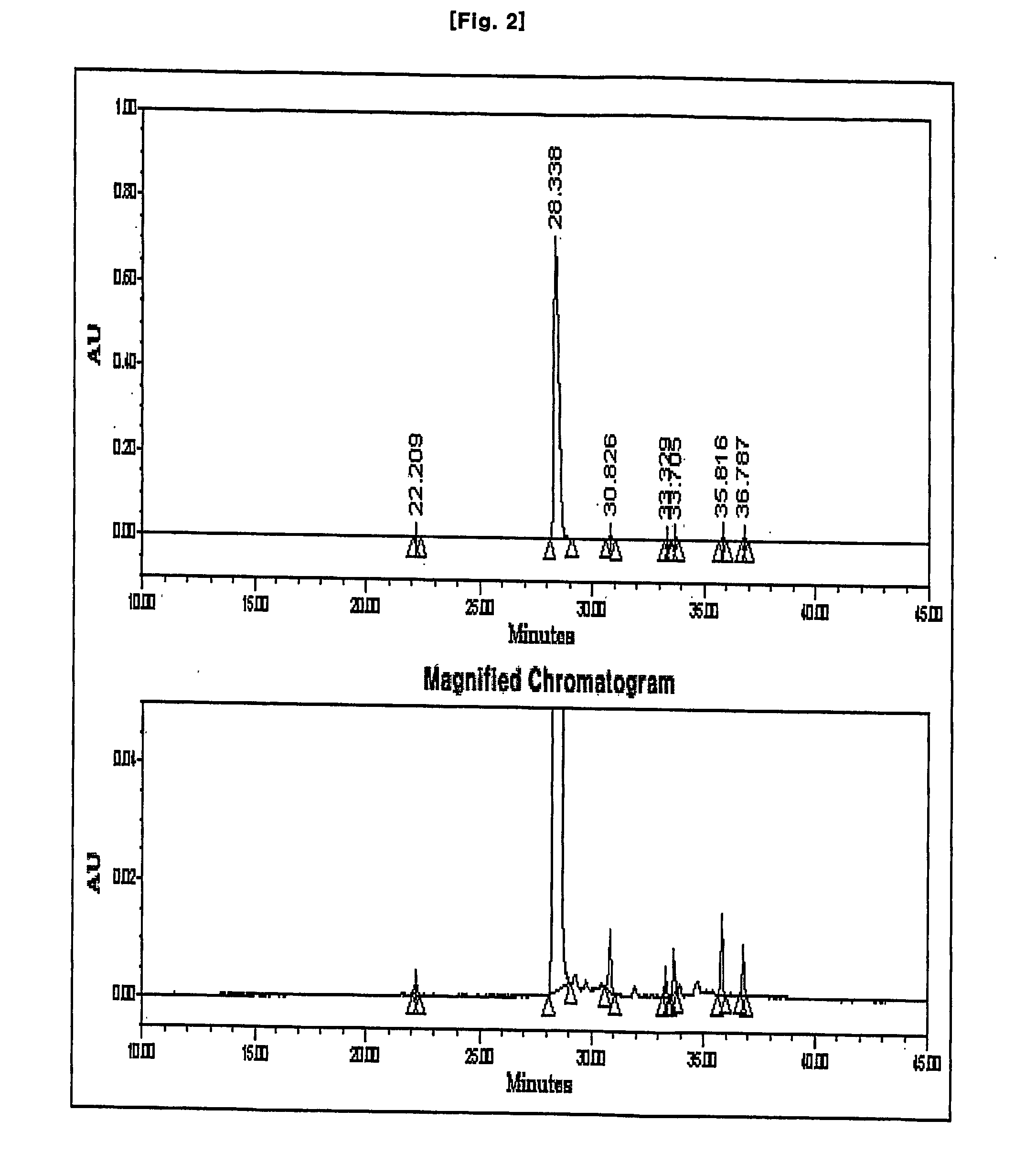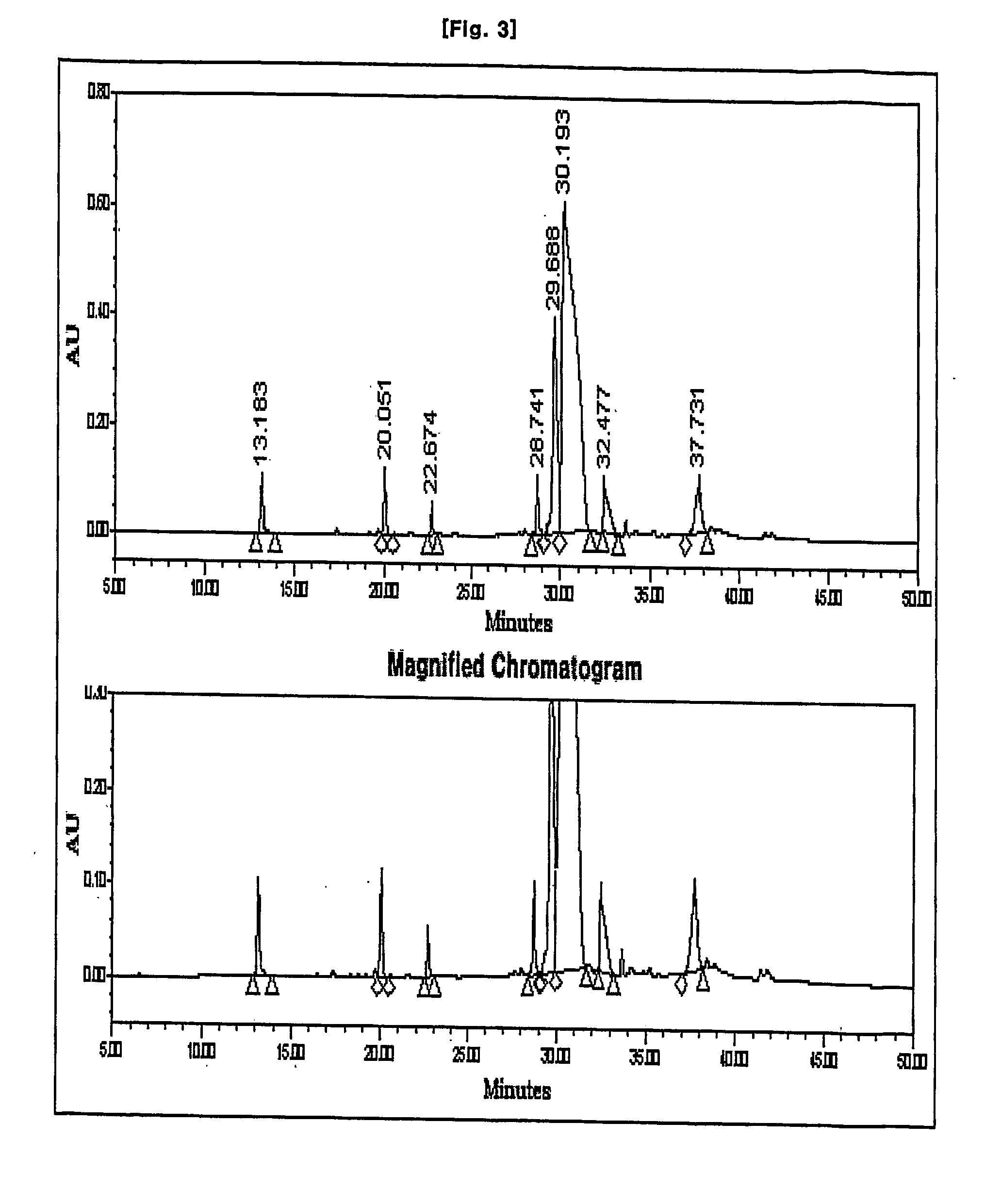Process for preparation of imipenem
a technology of imipenem and monohydrate, which is applied in the field of process for preparation of imipenem, can solve the problems of inability to form large amounts of impurities, low yield and purity of final products, so as to improve yield and quality, high purity, and low yield of imipenem monohydrate of formula i.
- Summary
- Abstract
- Description
- Claims
- Application Information
AI Technical Summary
Benefits of technology
Problems solved by technology
Method used
Image
Examples
example 1
Preparation of (5R,6S)p-nitrobenzyl-3-(diphenylphosphono)-6-[(1R)-1-hydroxyethyl]-1-azabicyclo[3.2.0]hept-2-ene-7-one-2-carboxylate
[0036] 20.0 g of (5R,6S)p-nitrobenzyl-6-[(1R)-1-hydroxyethyl]-1-azabicyclo[3.2.0]hept-3,7-dione-2-carboxylate of Formula III below was dissolved in a mixture solution of acetonitrile (100 ml), and tetrahydrofuran (100 ml). The reaction temperature was lowered to 0° C.˜−10° C. To the reaction mixture were sequentially added 11.1 g of N,N-diisopropylethylamine and 18.5 g of diphenylchlorophosphate. The resulting mixture was stirred for 1.5˜2 hours while maintaining the reaction temperature at −10° C., giving the enol phosphate of Formula IV below. The enol phosphate of Formula IV was used in the next step without further separation.
[0037] wherein R1 is p-nitrobenzyl.
[0038] wherein R1 is p-nitrobenzyl.
example 2
Preparation of (5R,6S)p-nitrobenzyl 6-[(1R)-1-hydroxyethyl]-3({2-[(1-isopropylidene)amino]ethyl}thio)-1-azabicyclo[3.2.0]hept-2-ene-7-one-2-carboxylate
[0039] A reaction solution of the enol phosphate derivative of Formula IV prepared in Example 1 was lowered from −40° C. to −60° C., and then 7.8 g of 2-aminoethanethiol hydrochloride and 11.1 g of diisopropylamine were sequentially added thereto. The reaction mixture was stirred for 0.5˜1 hour at the same temperature. A ketone type solvent was added to the reaction mixture in the presence of a base, stirred, and crystallized. The obtained precipitate was filtered, washed with hexane, and dried under reduced pressure at room temperature, affording 20.5 g (yield: 80.0%) of the amine-protected thienamycin of Formula II.
[0040]1H-NMR (DMSO-d6, 300 MHz, ppm) δ 1.14 (d, J=6.3 Hz, 3H), 1.78 (s, 3H), 1.90 (s, 3H), 3.12 (m, 2H), 3.28-3.32 (m, 2H), 3.37-3.40 (m, 2H), 3.94 (m, 1H), 4.13 (dt, J=2.4, 8.7 Hz, 1H), 5.07 (d, J=5.1 Hz, 1H), 5.27 (d,...
example 3
Preparation of (5R,6S)p-nitrobenzyl-3-[[2-[(formimidoylamino)ethyl]thio]-6-[(1 R)-1-hydroxyethyl]-1-azabicyclo[3.2.0]hept-2-ene-7-one-2-carboxylate
[0044] After 20.0 g of the intermediate compound of Formula II prepared in Example 2 was added to a mixed solvent of distilled water and tetrahydrofuran, the reaction temperature was lowered from 5° C. to −5° C. or lower. To there action mixture were added 18 ml of N-methylmorpholine and 30.8 g of benzylformimidate hydrochloride. The resulting mixture was stirred at 0˜10° C. for 2˜3 hours, affording the compound of Formula V, which was used in the next step without further separation.
[0045] wherein R1 is p-nitrobenzyl.
PUM
 Login to View More
Login to View More Abstract
Description
Claims
Application Information
 Login to View More
Login to View More - R&D
- Intellectual Property
- Life Sciences
- Materials
- Tech Scout
- Unparalleled Data Quality
- Higher Quality Content
- 60% Fewer Hallucinations
Browse by: Latest US Patents, China's latest patents, Technical Efficacy Thesaurus, Application Domain, Technology Topic, Popular Technical Reports.
© 2025 PatSnap. All rights reserved.Legal|Privacy policy|Modern Slavery Act Transparency Statement|Sitemap|About US| Contact US: help@patsnap.com



